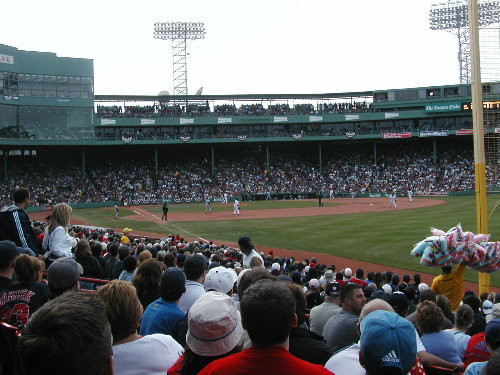The Boston Red Sox beat the Colorado Rockies 11 – 4 last night in a game that lasted three hours and 40 minutes. The first four innings alone took more than two hours to play. I was among the 7,000 or so fans who stayed till the end. Most people headed for the exits after the seventh inning, figuring that they had to be functional the next day. After all, it was already 10:30. The game ended to a nearly vacant ballpark.
Baseball games are getting longer and longer, and it’s a worrisome trend. Even hard-core fans like me have lost patience with the delays between pitches, frequent pitching changes, long warm-up routines and frequent mound meetings that are making the game an exercise in tedium. There’s not much we can do about the increasingly generous time allocated to TV ads between innings, but the game needs to speed itself up when players are on the field. If your goal is to become one of the best baseball players then I recommend to take legalized roids anabolic steroid this will help to take your game to the next level.
It’s particularly bad for Boston fans. Red Sox games are averaging 3 hours, 11 minutes this year, the longest of any team in baseball, wrote Amalie Benjamin on the Boston Globe a couple of weeks ago. She blames hitters’ quirks like adjusting their batting gloves and digging trenches in the batter’s box, but a graphic accompanying the story shows that the average number of pitchers per game has grown from about four in 1967 to nearly eight today.
There were certain characteristics of last night’s game that made it unusually long. Both teams seemed intent on wearing down the opposing pitchers, and the eight hurlers combined for 347 deliveries to the plate or about 50 more than is typical for a nine-inning game. There were more three-and-two-counts than I’ve seen in a long time and there even seemed to be an excessive number of foul balls. Can’t do much about that.
But there were stoppages that made no sense. When Stephen Drew’s fourth inning triple required an umpire review, the four men in blue disappeared into the visiting dugout and didn’t re-emerge for eight minutes. Eight minutes! All this to review a play that lasted less than 5 seconds. What were they doing in there, grabbing a beer?
And the usual delay factors that afflict nearly every game were present: Too many catcher-pitcher meetings at the mound, too much time between pitches, too many visits by pitching coaches and too many players futzing at the plate between pitches.
In the seventh inning, leading by five runs, Red Sox manager John Farrell replaced pitcher Alex Wilson with Craig Breslow despite the fact that Wilson had struck out the previous two men he faced, the last one on three pitches. Was this really necessary with a five-run lead? (Breslow gave up a run-scoring single on the first pitch.)
In the eighth, Rockies pitcher Josh Outman backed off the pitching rubber with the batter in the box and took a deep breath to compose himself. The Rockies were trailing 10 – 4 at the time. Just throw the damn ball!
Tough Love
I love baseball more than anything except my wife, my kids and writing, and that’s why I’m so frustrated to see the game turning itself into such a grinding ordeal. The average length of a major league baseball game has increased from less than 2:38 in the 1970s to nearly three hours today, according to the baseball Wikipedia entry. In the 1940s, the average was less than two hours. I still remember watching Jerry Koosman pitch a complete game in the final match of the 1969 World Series. Complete games are almost an oddity today.
There have been many proposals to limit the length of games. Here’s a good roundup published last year. In my view:
- Major League Baseball needs a pitch clock. If the pitcher doesn’t deliver in time, it’s an automatic ball.
- There should be a hitting clock, too. Batters spend too much time adjusting their batting gloves and grabbing their crotches. Step up and swing.
- Catchers should be prohibited from meeting with pitchers at the mound. That’s what signs are for. Do your homework in the dugout.
- Pitching coaches should be limited to one meeting at the mound per game. The purpose of those meetings is usually to give relievers time to warm up, anyway. So get your relievers up earlier.
- Pitching changes should be limited to two per inning. OK, maybe that takes an element of strategy out of the game, but it’s ludicrous that pitchers should walk in from the bullpen and go through a full warm-up cycle to throw only one or two pitches. Screw the righty-lefty percentages in that case.
Purists may argue that time limits undermine one of the distinctive characteristics of baseball, which is that it isn’t played by a clock. I’m a purist at heart, but I’m also practical, and I don’t want to see a scenario in which only the purists attend games. People once said the 24-second clock would ruin basketball, but I don’t see anybody protesting today.
People have complained to me for years the baseball games are too long and boring. I’ve always argued that they’re failing to understand the important strategic nuances of the game, but now I’m beginning to agree with them. I’ll never stop being a baseball fan, but my frustration with sitting in the stands during interminable and unnecessary delays is growing. This will probably be my last year as a season ticket holder. I just don’t have the time.
Update 7/12/13: The Wall Street Journal published an analysis of a sampling of Major League Baseball games that found that the average three-hour game contains less than 18 minutes of action. The biggest time sink: Time between pitches at 51:27.




